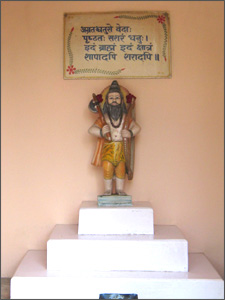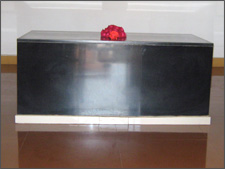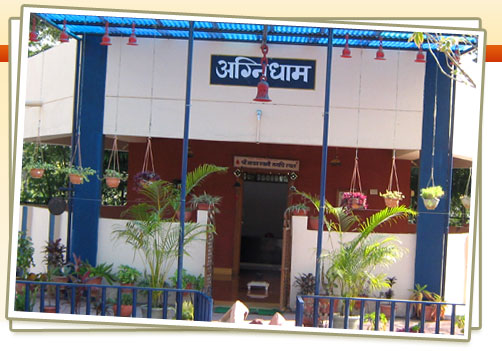 |
| |
Agnihotra’s Preceptor (Updeshta) Shri Madhavswami Potdarsaeb’s Sadguru – Paramsadguru Shree Gajanan Maharajshree is devotedly referred as ‘Shree’.
Shreeji’s birthplace is Kharagpur in the state of West Bengal in India. His family belonged to Raipur in Madhya Pradesh. His father was Shri Laxmanrao Rajimwale and mother Smt. Godavaribai (Sonamata) Rajimwale. Theirs was a renowned and very affluent family. However, the natural tendency of both his father and mother was towards spirituality. Father Laxmanrao’s temperament was that of a recluse. He embraced Sanyas in 1954 and adopted the name of Swami Shivanand. Shree’s mother too was a Sanyasin in mind and spirit. Staying in the hermitage at Sakori near her Sadguru Shri Upasanibaba for 2-3 years fully engrossed in observing spiritual disciplines she discarded her body in 1925 at a very early age. At that time Shree was only 6 years old and his younger sister was 3 years in age. Their bringing up was later on taken up by Sonamata’s uncle and aunt, that is, Shree’s maternal grandfather and grandmother in Akkalkot.
Akkalkot is in Solapur distcrict of Maharashtra.It is a well known pilgrimage place. It enjoys this status because of the great saint Shri Swami Samarth Maharaj. He is such a saint whose fame was spread all over India. Even more than 100 years ago devotees from all over the country used to visit Akkalkot for Swamiji’s Darshan. Swamiji never used to give any discourses or religious instructions but through his demeanour and brief, terse talks he used to give the message of virtuous conduct. People looked at him as the most eminent spiritual Guru. Questions pertaining to his personal details like wherefrom he had come, what is his name etc. always remained unanswered. His age too was not known. Some expert Indian and foreign Doctors had examined his skin and their unanimous verdict was that Swamiji’s skin was around 350 to 400 years old. He was an imposing yogi whose hands reached his knees – ‘Ajanubahu’. Even today thousands of people regularly visit Akkalkot for taking ‘Darshan’ of Swamiji’s place. People believe that Shree Swami Samarth is Lord Dattatreya’s incarnation. |
| |
|
One of Shree Swami Samarth’s disciple was Shri Balappa Maharaj who hailed from Karnataka. After Shree Swami Samarth’s Mahasamadhi Shri Balappa Maharaj established Balappa Math in Swamiji’s memory. After Shri Balappa’s Mahasamadhi the head of this Math was his disciple Shri Gangadhar Maharaj who was Shreeji’s maternal grandfather.
In 1938 Shreeji was installed as Head of Balappa Math. At this time his age was only 20 years. Incidentally just around this time he had also received a Guru-mantra from an invisible divine Master and so, forthwith adopting this mantra, he had started its repeated chanting. Observance of this discipline continued for the next 4 years. In the year 1942 he was initiated by a second mantra and this time he came to know that his spiritual Guru-Master, who had remained invisible so far, is none other than Lord Parshuram himself.
In 1944, following the command of Lord Parshuram, Shree took the Supreme Vow – “ I will resuscitate the Vedas”. Immediately after this, on the same day, with the grace of the Lord, Shree composed a Sanskrit verse – ‘Sapta-Shloki’ (Dharmadesh) – Seven Verses – his direct commandment for a code of conduct based on the Vedas. Today this ‘Sapta-Shloki’ is chanted all over the world after performance of morning – evening Agnihotra. Strangely, right from 1944 and upto 1958 nobody could comprehend the importance of this lucid verse composed by Shree, though in between this period many had come in contact with the Master and become his devotees. In 1954 Shri PotdarSaheb (Madhavswami) met Shreeji for the first time. In 1959 it was PotdarSaheb who translated ‘Saptashloki’ in Hindi for the benefit of all to understand its importance. ‘Saheb’ was so greatly impressed by the knowledge he gained through this translation that spontaneously he composed a poem and through it expressed his most cherished desire. Through this poem he appealed to Shree stating ‘May my life be spent in the propagation of religion (Satya Dharma)’. Consequently, on Shree’s command ‘Saheb’ wrote in English a book ‘In Search of Happiness’ in 1959. Now, by sending him on travels to wander all over India, through ‘Saheb’, Shree gave a divine message to all the four directions. This done, he commanded ‘Saheb’ to independently do the propagation of Satya Dharma. In 1959 itself, as desired by Shree, “Saheb” took the Vow – “I will do the resuscitating work of the Vedas with single minded devotion.” |

Shreeji's Sadguru
(Lord Parshuram ) |
| |
|
When ‘Saheb’, on his own initiative first introduced and then started propagation of morning – evening Agnihotra, Shreeji expressed great happiness and said “this is what we desired. This is what is intended by us.” Now Shree started taking interest in ’Saheb’s’ work and would sometimes make certain suggestions. Not only this, Shree started sending his devotees/disciples to ‘Saheb’ to learn Agnihotra and seek guidance from him in matters concerning propagation work. People consider Shreeji as the incarnation of Lord Kalki but Saheb always regarded him as the Almighty, Supreme Power in visible human from. A divine soul illumined by the celestial light of the Almighty which appears amongst us only sometimes in thousands of years.
In the month of May in 1963, through his disciple Shri Sakha Hari Apte, Shree rejuvenated the Vedic ‘Tretagni’ vistar Agnihotra (in which the fire is kept alive round the clock in three altars) in Apte’s house at Mapusa in Goa. Only a person performing such type of Agnihotra can perform the Veda ordained Somayaga. Accordingly, establishing a yagna township near Swami Shivanand’s Samadhi and giving it the name of Shivpuri in Akkalkot a Vedic Somayaga was performed in February, 1969 under the guidance of Shree.The peculiar feature of this Somyaga was that it was non-violent (without any animal sacrifice) and performed strictly following the pure and clean process prescribed by the Vedas. This earned it the attribute of a matchless yagnya. At the Yagnya site is standing today a majestic Yagnya Pillar in the memory of this matchless yagnya. This is that same place Shivpuri which is very dear to Shree.
|
| |
|
The actual practice of Agnihotra found a place in Akkalkot’s morning – evening daily routine only by the latter part of 1973. This was exactly 10 years after the first Agnihotra of this world which ‘Saheb’ had gotten started in Bairagarh, Bhopal. In 1972 Shree sent Shri Vasant Paranjpe to America for propagation of Agnihotra. Prior to this Shri Vasant had met ‘Shrisaheb’ at Ujjain in 1970 and on his instructions had commenced practice of Agnihotra on 3rd March, 1970 in his house at Belgaum in Karnataka. Shri Vasant had deeply studied ‘Saheb’s’ book ‘Dharmapaath’ and ‘In Search of Happiness’ and then wrote the book’Grace Alone’ before proceeding abroad.
Constantly linked with several rigorous spiritual disciplines and austerities Shree’s life is uniquely wonderful. To just feel his touch, to get his neamess, guidance, blessings and a few words of solace Agnihotra practitioners from all over the world used to come near his Lotus Feet. In 1983 Shreeji left the Math and came to live in Shivpuri. On 6th December, 1987, at around 9 P.M. in the night he discarded his body. Here, at Shivpuri his body was consigned to the flames on 7th December 1987. One for whom fire worship was most dear got himself merged with fire. This is why it is said that people will continue to get Shreeji’s virtual ‘darshan’ ages after ages in the sacred fire within which he dwells now, that is, we will be able to see Shree only in the Sacred fire of Agnihotra Yagnya.
|

Shreeji's Samadhi at
Madhavashram |
| |
|
Shreeji visited Madhavashram, Bhopal on three different occasions.
Shree came for the first time to Bhopal on 23rd, 24th May, 1976. He stayed for one night in Madhavashram. It was during this visit he placed with his own hands the vessel containing mortal remains of Shri Madhavswami in the specially built vault and thus laid the foundation of ‘Agnidham’ here.
Shree’s second visit was in December 1983. This time he stayed for three days in Madhavashram. On this occasion where he camped for three days that place is called ‘Shree Nivas’ and this presently is the residence of the Potdar family. Shree had particularly come to express satisfaction on the progress of the construction work of ‘Agnidham’. Availing this opportunity thousands of Agnihotra practitioners from all over India had assembled in Madhavashram. A useful conference with various programmes took place on this occasion.
Shree’s third visit to Madhavashram was in 1985 when he stayed here for 8 days. With the intention of eradicating the harmful effects of the horrible chemical diasaster in Bhopal, that shook the whole world, the performance of a Mahasomyaga was arranged in Madhavashram from 15th to 21st May, 1985. Shree remained present for the whole period of the yagnya. On this occasion thousands of people from the country and also from foreign lands came to attend. This time Shree’s birth-anniversary was celebrated enthusiastically in Madhavashram on the night of 16th May, 1985.
|
| |
|
|
| |
|


